After two years of two liter unblown (F2) Grand Prix cars, dominated by the Ferrari 500 of Ascari, the FIA announced that new rules for formula one cars would be applied at the beginning of 1954: a maximum capacity of 2.5 liters for the engines without compressor and only 750 cc if supercharged. Unlike today’s complex cars and rules, there were few other requirements for the new formula.
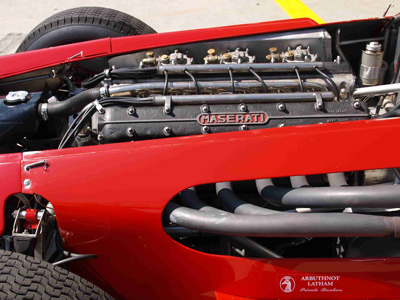
1954/56 type Cameron Millar replica, chassis CM 5.
|
During the 1952-53, Maserati had made use of the the A6GCM, a good car but one which was overshadowed by the speed and handling of the Ferraris. By the end of the 1953 season, however, it was well developed and Fangio won the Italian Grand Prix, the last race of the Formula 2/Formula 1 years. It proved to be a good basis on which to built a car for the new formula.
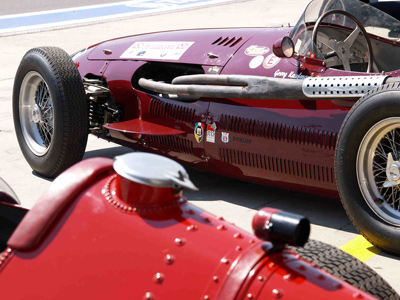
CM5 and CM8, both 1954/56 Cameron Millar replicas.
|
At Maserati, engineers Giaocchino Colombo, Alberto Massimino and Bellentani designed a new engine, derived from the two liters of the A6GCM.
Retaining the straight 6 cylinder, the bore was increased from 76.2mm to 84mm and the stroke remained the same at 72mm, for a total displacement of 2493cc. The pistons and liners were inserted into a aluminum block and crankcase. The 12 valve head had two overhead camshafts, two magnetos, three dual-throat 42mm Weber carburetors and a six branch exhaust system. Notably, the engine was put together without gaskets, using only joint compound. The engine developed around 220 reliable horses in early 1954.
The four speed gearbox was combined with the final drive and ZF limited slip, all located by a De Dion rear axle, new to the 250F.
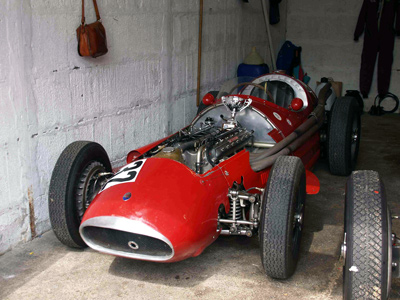
Chassis 2508, ex- Stirling Moss which he raced from 1954-56 and had many victories.
|
Responsible for the chassis, transmission and braking system was Valerio Colotti. Colotti would help create the 250F in its very last guise, as the Tec- Mec in 1960, and also become famous for his gearboxes.
The work as a team was not easy, but the final result was very good and satisfactory for the test driver Guerino Bertocchi, in his first drive with the car on December 26th 1953. It was claimed that 174 mph was reached at the Modena Aerodrome. Amazingly, Bertocchi had acted as riding mechanic for Alfieri Maserati some 28 years before in the 1926 Targa Florio.
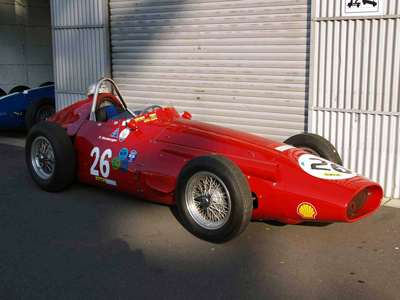
Maserati 250F chassis 2526.
|
The name of the car was initially 6C2500 (which was too much like the earlier Alfa Romeo model designation) or 250/F1, and then more simply 250F where 250 was a contraction of 2500, the capacity of the engine in cubic centimeters.
From 1954 to 1958, thirty three 250F were produced with chassis and engine numbered from 2501 to 2534. The exception of the 2517, probably because 17 is thought to be an unlucky number in Italy.
The 2513 should be only a chassis (for Tony Vandervell), and of course some chassis have been renumbered after crashes or significant changes. Denis Jenkinson also lists five “interim” A6GCM/250Fs which were numbered 2501 to 2504 and 2510, which spoils an otherwise very elegant chassis number history.
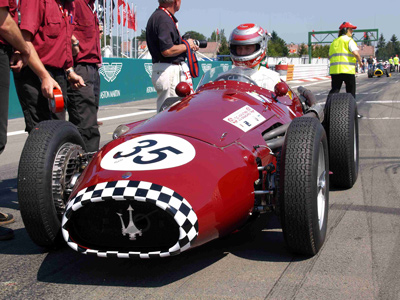
Chassis 2521 is Jean Behra's works car from 1956.
|
In 1957 the development of the engine was at its limit and a new engine was designed. Surprisingly, it was a flat (180 degree) 12, in order to have a very low profile. However, it was found that a 60 degrees V12 could better fit into the existing chassis of the 250F.
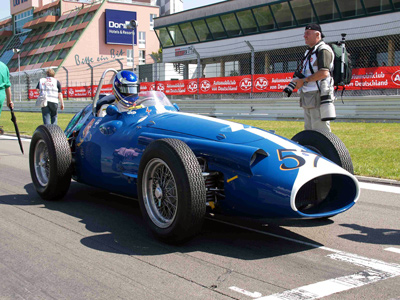
Chassis 2534, the last built and second "piccolo" car from 1958.
|
The chassis had to be improved for the season 1957. Six smaller and lighter chassis with a lower and more aerodynamic body were produced (the so called “lightweight”) and used both with the six and twelve cylinder engine.
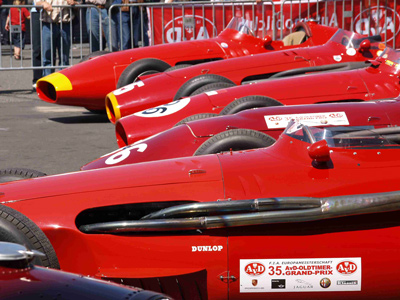
Red Nosed Maseratis.
|
Financial problems at the end of 1957, notwithstanding the World Championship gained by Fangio, caused the slow down of the development of a new chassis and soon all racing activities at Modena ceased as Maserati was forced to withdraw from racing.
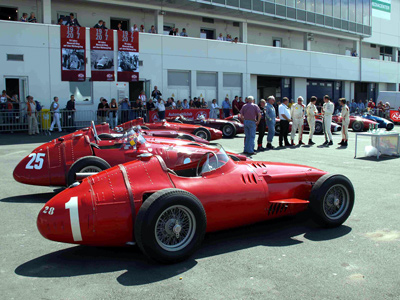
All the 250F which were present at the Oldtimer’s GP lined up for prize presentation.
|
Factory and privateers campaigned the 250F from 1954 till 1957 and then again in minor events until 1960. The 250F won 55 victories and one World Championshipship with Juan Manuel Fangio in 1957.
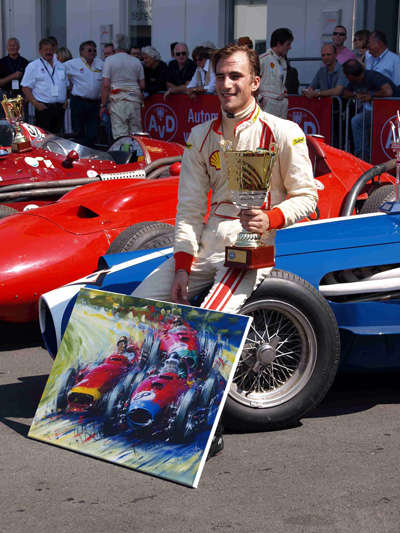
Max Werner, winner of the race, with the cup and a nice painting of Fangio's car in action.
|
Other famous drivers of the 250F have been Moss, Musso, Prince Bira, Ascari, Villoresi, Mantovani, Marimon, Schell, Salvadori, Hawthorn, Taruffi, Brabham, Bonnier and many others, including Maria Teresa De Filippis, the first woman to drive a Formula 1 car.
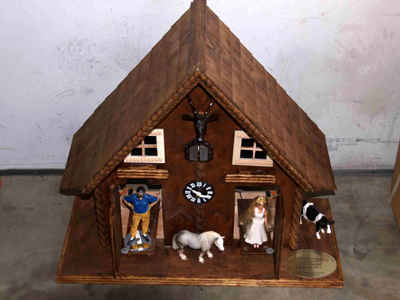
An unusual carillon celebrating Fangio's victory in 1957. Fangio in the left door.
|
The increase of vintage racing events all over the world encouraged the building of replicas: the most important ones are those of Cameron Millar, identified by CM instead of the chassis number. They are very hard to tell from the originals and are widely accepted in historical events.
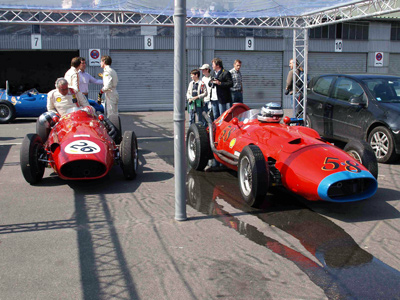
Chassis 2526 and 2531, two 1957 cars. The 250F at right has a 12 cylinders engine.
|
A Few 250F are also displayed in museums in New Zealand, Mulhouse in France, Biscaretti in Turin, the Donington collection in UK and the Fangio museum in Argentina.
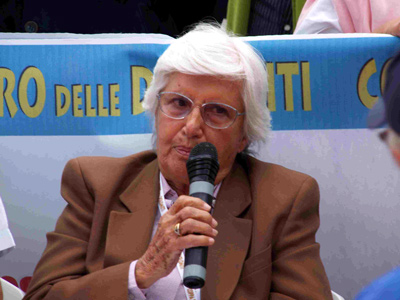
Maria Teresa de Filippis raced the 250F in 1958 and 1959 (picture taken at the Coppa d'Oro in Cortina d'Ampezzo 2007).
|
This year at the Nurburgring Oldtimer Grand-Prix, there was a celebration of 50 years since Fangio’s great victory with the Maserati 250F.
A total number of 11 250Fs were present: eight produced by Maserati and three Cameron Millar replicas.
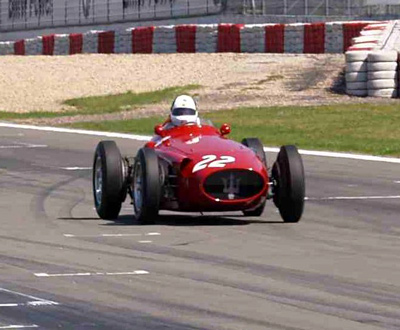
CM7 a "piccolo" replica by Cameron Millar.
|
A special prize was given to Max Werner, winner of the special race driving the last car produced by Maserati (2534), a “piccolo” version with the six cylinders engine.
ESSENTIAL BIBLIOGRAPHY:
Anthony Pritchard MASERATI, A HISTORY, ARCO 1976
Orsini Zagari MASERATI Ed. LDA 1980
Casucci RIVISTA MASERATI Ed. AUTOMOBILIA 1986
Auth.V. RIVISTA MASERATI n. 3 Ed. G. NADA 1999
Reggiani MASERATI DA COMPETIZIONE NADA 2001
McKinney MASERATI 250F Ed. CROWOOD PRESS 2003
Maserati articles in VeloceToday:
Alf Francis and the Moss 250F
250F Owner's Manual
Maserati by Tabucchi
Maserati VS Ferrari
Maserati History Part 1
Maserati History Part 2
Maserati History Part 3



